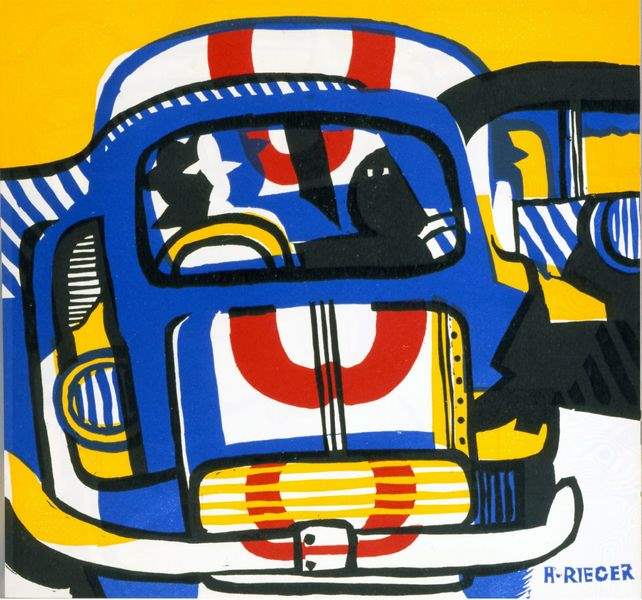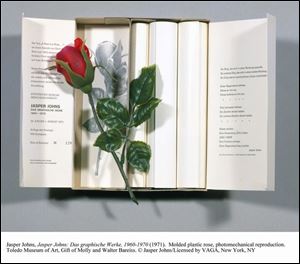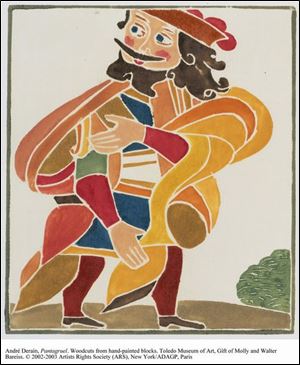
A splendid collection of books
2/9/2003
Helmut Rieger's fanciful rendition of an automobile.
HO

Helmut Rieger's fanciful rendition of an automobile.
The big Van Gogh show's not due in town for another two weeks. But don't wait around for Vincent.
The Toledo Museum of Art has some of its own finest treasures going on display on Valentine's Day. It may be more worthwhile.
It's called “Splendid Pages: the Molly and Walter Bareiss Collection of Modern Illustrated Books.”
It's a show of books - or pages from books - like you've never seen. Pages and prints by Picasso, Bonnard, Chagall, and Baselitz, Jasper Johns, Braque, Anselm Keifer, and Kiki Smith, hanging on the walls, open under glass, unfolded, bound, unbound, boundless.
Not picture books. Not books about art.
Artist-illustrated books. An old idea, but a new art-genre trend. Toledo's art museum has an edge on most of the museum world where this one's concerned: Its founding director, George Stevens, loved these artistic oddities, and left his collection to the museum back in the 1920s. Toledo has a print study room, a works-on-paper curator, and for many decades was one of only three or four American museums that bothered with books. Meanwhile, top artists delighted in collaborating with authors and publishers to produce them.

A photomechanical reproduction of a rose, by Jasper Johns.
The texts range from poems by Ovid and Virgil to Dada ditties, Eric Satie opera scores, an essay on time by horrormeister Stephen King, and a consideration of endocrinology by Mei-Mei Berssenbrugge.
Through the years, a few sharp-eyed, adventuresome collectors made a habit of picking up these inexpensive, terribly rare, limited-edition books.
One of them was Walter Bareiss, a German-American industrialist whose passion for collecting is rooted in childhood.
He started with stamps. He was taken to dozens of Europe's finest museums by a family friend, and for his 11th birthday little Walter asked for a Picasso print. On school field trips he spent his 12-cent allowance on Aristide Maillol woodcuts, on sale for about 5 cents each at Munich magazine stalls. While at Yale he bought his first Japanese illustrated books and prints - famous names like Hiroshige, Hokusai, and Sharaku - as well as a Picasso-illustrated book. He paid $200 for it.

A colorful woodcut from Andre Derain.
It was only the start of a lifetime of collecting, bidding, pursuing, and commissioning art from top artists and writers, and serving on boards at some of the world's top museums.
“In addition to the fun of finding, buying, and studying these books for over 60 years, collecting them led to innumerable adventures, produced myriad friendships, and yielded immense satisfactions,” Mr. Bareiss said in an essay written for the show catalog. His travels turned up Picasso, Tony Bevan, Hermann Nitsch, Henri Matisse, Max Beckmann, Robert Rauschenbert, and Robert Motherwell. Fairfield Porter painted Bareiss family portraits. Georg Baselitz created the Bareiss library book plate.
Meantime, he married Molly, a student at Bennington College in Connecticut. Molly's best friend, Bobbie, married a man from Perrysburg, Ohio. The couples remained friends over the years, and the Bareisses enjoyed visiting the Toledo museum when they were in town.
And that's how 1,100 illustrated books, folios, drawings, and illustrations ended up in Toledo in 1984.
The Bareisses love buying things. And they like to give them away.
“Our collection of illustrated books has found an excellent home in the Toledo Museum of Art,” Mr. Bareiss said. We wanted to donate [it] to an institution that had an interest in artists' books, as well as an excellent print department. We felt strongly it should go to an area of the country where there was no large library of 19th- and 20th-century books ... When [the late] Bobbie Sutherland suggested Toledo, it seemed like a perfect match.”
Since the original bequest in 1984, the Bareiss donation has increased to about 1,400 items, said curator Julie Mellby.
“They continued to give, and we continued to buy items in conjunction with them,” she said. “And as we cataloged their collection, we kept finding some extra things mixed in - magazines and periodicals by and for artists. Facsimile sketchbooks. Portfolios with sequential groups of images that tell a story. Is that a book? That never bothered Walter. He was the adventurer, a true connoisseur. He set the standard.”
Mr. Bareiss said it wasn't anything so high-falutin' as all that.
“To me, nothing beats pulling a book out of the bookcase on a rainy afternoon and enjoying it as a total object,” he said. “Text, illustrations, layout, paper, binding. And so much easier than taking a print off the wall!
“It's often possible to purchase drawings, color sketches, collages, or trial proofs [that are] sometimes better than the final versions ... When I started collecting, books - except for deluxe editions - were considerably less expensive than prints. For the price you might pay for a single [signed] print, you got several, even hundreds, in a book.”
“This show is a Valentine for Toledo, a Valentine to the Bareisses,” Ms. Mellby said. “Its multicultural, multigenerational, and truly international.”
“And it's a knockout display,” said museum director Roger Berkowitz.
“Splendid Pages: The Molly and Walter Bareiss Collection of Modern Illustrated Books” opens at the Monroe Street museum Feb. 14, and will remain on display through May 11. Tickets are $6 for adults, $5 for seniors and students, free for children under 5 and museum members. When “Van Gogh: Fields” opens, discounted combined tickets for both shows will be available. An audio tour of both shows is available at extra cost.
“Splendid Pages” is open Tuesdays through Thursdays 11 a.m. to 4 p.m.; Fridays 11 a.m. to 11 p.m.; Saturdays 10 a.m. to 4 p.m.; and 11 a.m. to 5 p.m. Sundays. An array of panel discussions, lectures, and classes is offered through April.